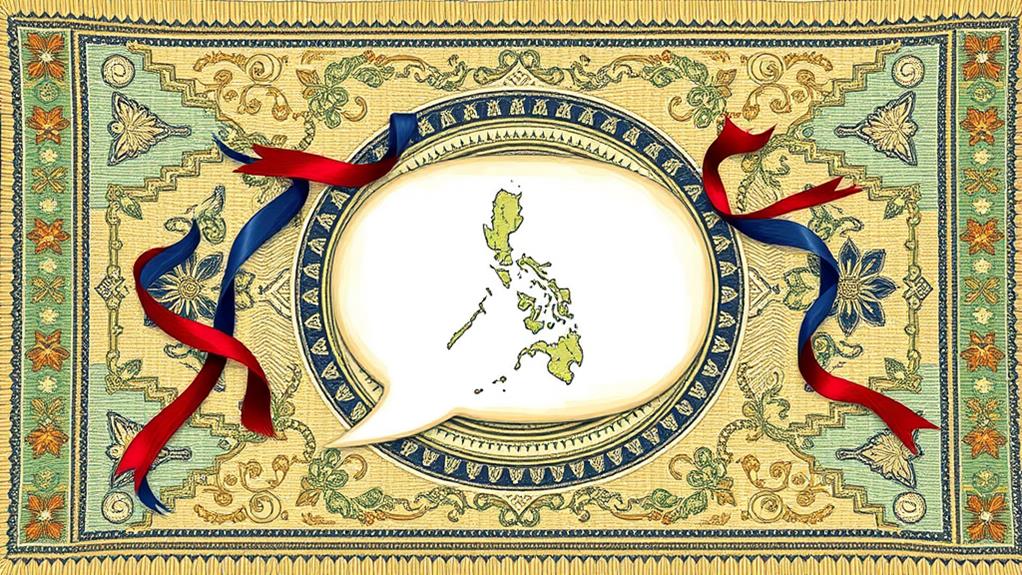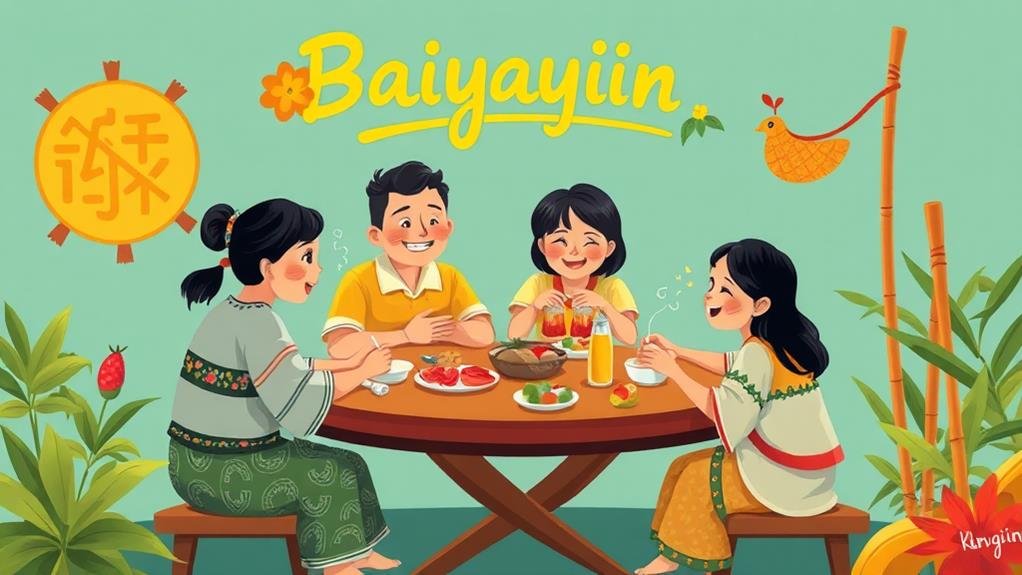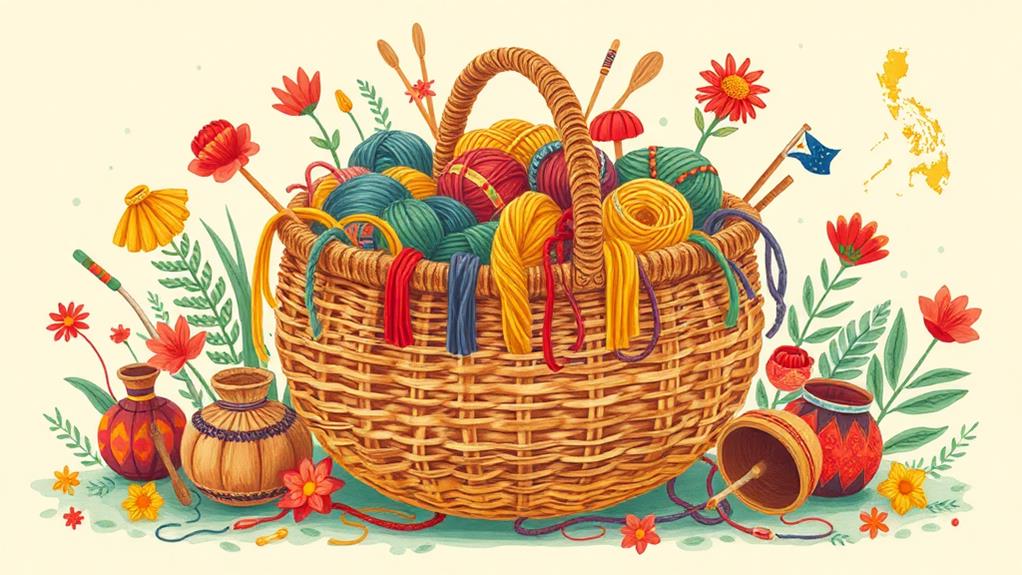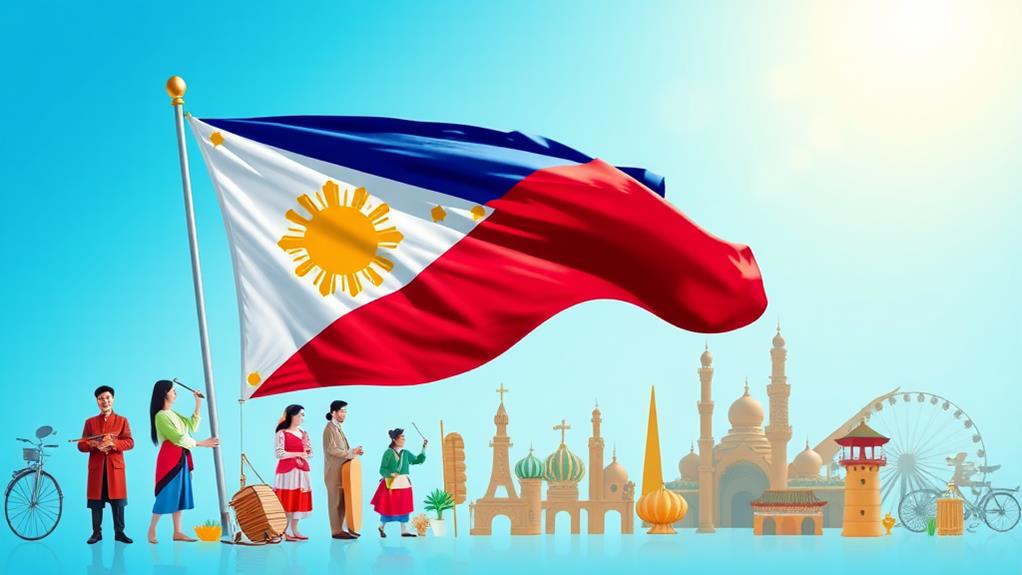Tagalog is the language of national unity in the Philippines, serving as a common thread among over 182 ethnolinguistic groups. This is because Tagalog is the basis of the national language, Filipino, which is used as a lingua franca across the country.
Tagalog preserves traditional stories, folklore, and values, such as the epic poem "Lam-ang" and the folklore of "Aswang". These stories are passed down through generations, teaching cultural values like respect for elders and the importance of family.
Tagalog incorporates loanwords from Spanish and Chinese, reflecting cultural fusion and historical influences. For example, the word "kumusta" (how are you) comes from the Spanish "¿cómo estás?", while "pancit" (noodles) comes from the Chinese "面食" (miàn shí).
Tagalog conveys complex emotions and values, such as "hiya" (shyness) and "utang na loob" (debt of gratitude). These emotions and values foster community identity and social bonds, shaping the way Filipinos interact with each other.
Tagalog reinforces national pride and cohesiveness, particularly during festivals and rituals. For instance, the "Panagbenga Festival" in Baguio City celebrates the city's cultural heritage, while the "Pabasa ng Pasyon" ritual during Holy Week recounts the passion of Christ.
By exploring Tagalog's role in Filipino culture, it becomes clear that Tagalog is the integral thread that weaves the complex fabric of Filipino culture together.
Language of National Unity

The national language of the Philippines is Tagalog, declared as such in 1937. This declaration has had a profound impact on the country's diverse linguistic landscape, where over 170 languages are spoken.
Tagalog's widespread use enables effective communication across linguistic groups, promoting national identity and cohesion. This is evident in daily conversations, where Tagalog blends with English, known as Taglish, to enhance social interactions and cultural expression.
Tagalog plays a crucial role in shaping Filipino culture, facilitating the dissemination of shared values and traditions. For instance, the language incorporates Spanish loanwords, reflecting the country's rich cultural heritage.
By embracing Tagalog as the national language, Filipinos contribute to a sense of unity that transcends regional and linguistic boundaries. This unity is essential in a nation with diverse regions and backgrounds, allowing individuals to connect with fellow Filipinos and share a common identity.
Preserving Cultural Heritage
Tagalog Preserves Filipino Cultural Heritage
Tagalog is a gateway to the Philippines' cultural soul, preserving traditional stories, folklore, and values passed down through generations.
It serves as a conduit for cultural expressions, incorporating loanwords and expressions that reflect the rich history of interactions with various cultures, such as Spanish and Chinese, making it integral to the preservation of Filipino identity.
Tagalog Facilitates Cultural Connection
Through its use in cultural practices, such as festivals and rituals, Tagalog facilitates a deeper connection to Filipino heritage and communal identity.
For example, the Sinulog Festival in Cebu celebrates the Santo Niño, a symbol of Filipino Catholicism, where Tagalog is used in prayers and chants.
Documenting Tagalog Dialects Preserves Linguistic Heritage
Efforts to document and teach Tagalog dialects and variations across different regions contribute to the safeguarding of the diverse linguistic heritage that shapes the broader Filipino cultural landscape.
For instance, the documentation of the Batangas Tagalog dialect has helped preserve the region's unique cultural practices and traditions.
Shaping Filipino Identity

Tagalog: The Unifying Force of Filipino Identity
Tagalog plays a crucial role in shaping the Filipino identity, binding together diverse ethnic groups into a rich tapestry of shared values and experiences.
Linguistic Unity
Over 85% of the population shares a common language, fostering national pride and cohesiveness. This unity enables effective communication across regions, facilitating social and economic development.
Cultural Continuity
Tagalog promotes cultural continuity by preserving traditional values and beliefs through education, media, and government. This allows for the effective transmission of cultural heritage across generations.
Cultural Blending
Tagalog integrates loanwords from Spanish and English, reflecting the cultural fusion that defines Filipino identity. This blending of languages has given rise to a unique cultural identity.
Adaptive Nature
The prevalence of Taglish, a hybrid of Tagalog and English, showcases the adaptive nature of the Filipino language. This hybrid language has become an integral part of everyday life, embracing modernity while honoring tradition.
Encapsulating Filipino Values
Tagalog expressions and idioms reinforce cultural norms such as hospitality and bayanihan, deepening the connection to Filipino heritage. This reinforcement fosters a sense of belonging and shared purpose among diverse ethnic groups.
Communication and Social Harmony
Effective Communication Across Cultures
In the Philippines, over 170 ethnolinguistic groups rely on Tagalog as a common language, facilitating seamless communication and social harmony across diverse communities. This shared language allows people to connect and understand each other, bridging cultural divides.
Adaptability in Modern Contexts
Tagalog's adaptability is evident in the use of Taglish, a blend of Tagalog and English, which makes communication more relatable in modern contexts. This blending of languages enables effective communication in various settings, from casual conversations to formal gatherings.
Respectful Communication
Respectful communication in Tagalog is reflected through specific terms of address, particularly towards elders, reinforcing social harmony and respect. For example, using "po" or "opo" to show respect when speaking to older individuals is an integral part of Filipino culture.
Filipino Greetings and Expressions
Filipino greetings and expressions, deeply rooted in Tagalog, establish rapport and embody the warmth and friendliness characteristic of Filipino culture. For instance, "Kumusta?" (How are you?) is a common greeting that sets a positive tone for interactions.
Fostering Social Harmony
Through Tagalog, you experience the Filipino concept of "kapwa," or shared identity, which emphasizes collective well-being and mutual support.
Expressing Emotions and Values

Tagalog: A Language of Nuanced Emotions and Values
Tagalog speakers rely on their native language to convey complex emotions and values that may be lost in translation. One such value is hospitality, which is deeply rooted in the Filipino culture. This value is fostered through the use of Tagalog, creating a sense of community and shared identity among speakers.
The use of Taglish, a blend of Tagalog and English, reflects the adaptability of Filipinos in expressing emotions and values in a modern context while maintaining cultural roots. Tagalog's rich vocabulary includes terms that encapsulate unique Filipino concepts, such as "hiya" (shame) and "utang na loob" (debt of gratitude). These terms are essential for understanding social norms and interpersonal relationships.
Greetings and expressions of affection in Tagalog are emotionally deep and warm, highlighting the importance of social bonds and familial connections.
For example, "Mahal kita" (I love you) is a common expression of love and affection in Tagalog. Through Tagalog, complex emotions can be articulated in culturally meaningful ways, making it an integral part of Filipino identity.
Storytelling and Oral Traditions
Storytelling and Oral Traditions in Filipino Culture
Conveying History and Identity
In the Filipino culture, storytelling is a powerful tool for conveying history, heritage, and cultural identity. Through oral traditions, Filipinos share their emotions and values with each other, passing them down through generations.
Traditional Epics and Cultural Diversity
Traditional epics like "Biag ni Lam-ang" showcase the heroic tales and cultural beliefs unique to specific regions, highlighting the diversity within the Philippines.
These epics demonstrate the rich cultural heritage of the Filipino people.
Oral Traditions and Cultural Values
Oral traditions often incorporate elements of folklore, religion, and moral lessons, enabling listeners to connect with their heritage and cultural values through engaging narratives.
These stories help Filipinos understand their cultural identity and values.
Storytelling in Festivals and Community Gatherings
Festivals and community gatherings frequently feature storytelling, where oral performances serve not only as entertainment but also as a means of reinforcing social bonds and cultural pride among Filipinos.
These events bring people together, celebrating their shared cultural heritage.
Understanding Filipino Identity
Through storytelling and oral traditions, you can gain a deeper understanding of the cultural values that define the Filipino identity.
These stories provide insights into the beliefs, customs, and history of the Filipino people, helping to preserve their cultural heritage.
Unifying Diverse Communities

Unifying Diverse Communities
Tagalog, the national language of the Philippines, serves as a common thread that weaves together the fabric of the nation, transcending linguistic and cultural boundaries that define the Filipino identity.
It facilitates communication among over 182 ethnolinguistic groups, fostering a sense of national unity.
Tagalog's adaptability in modern contexts is reflected in the use of Taglish, a blend of Tagalog and English, in everyday conversations.
This blend promotes inclusivity across diverse communities. The language's extensive vocabulary, enriched with loanwords from Spanish and English, allows for cultural exchange and understanding among different regions and backgrounds.
In schools, Tagalog serves as a medium of instruction, bridging educational gaps and enabling children from various linguistic backgrounds to access learning in a common language.
During festivals and cultural celebrations, Tagalog language elements are often incorporated, reinforcing communal ties and shared identities among Filipinos from different provinces.
Through Tagalog, diverse communities come together, fostering a sense of national unity and shared Filipino identity.
Cultural Exchange and Adaptation
Tagalog's adaptability facilitates cultural exchange and adaptation. This is evident in the language's ability to incorporate various cultural expressions and influences.
Tagalog's vocabulary reflects the country's colonial history. For instance, the integration of Spanish loanwords into the language demonstrates the impact of colonization on everyday communication.
Tagalog navigates local and global contexts effectively. The use of Taglish, a mix of Tagalog and English, is a prime example of this adaptability.
Regional variations in Tagalog dialects highlight diverse cultural expressions. These variations across the Philippine archipelago emphasize local identities while maintaining a shared linguistic foundation.
Tagalog's rich vocabulary is a testament to the Philippines' historical trade and cultural exchanges. The language includes terms derived from Indigenous, Chinese, and Arabic sources, showcasing the country's cultural interactions with various civilizations.
This adaptability has enabled Tagalog to become a catalyst for cultural exchange and adaptation, allowing Filipinos to engage with different cultures while maintaining their unique identity.
Influencing National Pride

Tagalog: The Unifying Force of Filipino National Pride
Through the widespread use of Tagalog as a national language, Filipinos across diverse ethnic groups find common ground, fostering a sense of national pride rooted in a shared linguistic identity.
Education and Government
Tagalog is the language of instruction in education and an official language in government, reinforcing national identity and solidifying its status as a symbol of national pride.
This helps preserve Filipino culture and heritage by promoting a shared understanding among citizens.
Artistic Expression and National Celebrations
Tagalog is the language of literature, music, and media, inspiring national pride through storytelling.
It's also the language of songs, poetry, and speeches during national celebrations, instilling pride in Filipino identity.
The Evolution of Tagalog: Taglish
The Filipino cultural landscape is characterized by the use of Taglish, a blend of Tagalog and English.
This unique identity showcases the adaptability of the Filipino language and culture, as Filipinos take pride in their ability to evolve while remaining true to their roots.
How Does Understanding Tagalog Identity Highlight Its Role in Shaping Filipino Culture?
Understanding Tagalog identity reveals the secret behind tagalog cultural identity, offering insight into how its language, traditions, and values have shaped Filipino culture. Rooted in resilience and unity, it embodies the core of the nation’s heritage, influencing customs, arts, and the collective spirit that defines the Filipino people.
Reflecting History and Experience
Reflecting History and Experience
Tagalog reflects the history of the Philippines, showcasing the country's rich cultural heritage. The language has absorbed influences from various cultures, including Spanish Colonial, Chinese, and American, due to the Philippines' complex history of trade and colonization.
Tagalog's vocabulary contains loanwords from Spanish, a reminder of the 300-year Spanish colonization that shaped Filipino society. For example, the Tagalog word "kabisera" (capital) comes from the Spanish word "cabecera".
The language has also borrowed from Chinese, reflecting the significant trade and cultural exchanges between the two nations. The Tagalog word "tsinelas" (slippers) is derived from the Chinese word "chinela".
Tagalog has incorporated American English words, highlighting the Philippines' experience as a US territory from 1898 to 1946. Many Tagalog words related to technology, such as "kompyuter" (computer), come from American English.
Tagalog's evolution reflects the Filipino people's collective experiences, values, and philosophies. The language has preserved and promoted Filipino traditions and values, allowing generations to connect with their historical experiences and cultural heritage.
Frequently Asked Questions
How Is Philippine Culture Shaped?
Philippine culture is shaped by a combination of factors, including language, historical context, social interactions, and art expression. The widespread use of Tagalog as a lingua franca fosters a shared cultural identity across the archipelago. This shared identity is reinforced through Tagalog phrases and expressions that emphasize cultural values like community and respect for elders.
For example, the phrase "po" and "opo" are used to show respect to elders, while "kumusta" (how are you) and "salamat" (thank you) promote a sense of community.
Traditional festivals and holidays celebrated in Tagalog also play a significant role in defining Philippine culture. These celebrations emphasize the importance of community and spirituality, such as the "Fiesta ng Kaluluwa" (Festival of Souls) which honors the dead, and the "Simbang Gabi" (Night Mass) which is a series of nine dawn Masses leading up to Christmas.
These events bring people together, strengthening social bonds and reinforcing cultural values.
What Are the Key Factors That Influenced the Philippines Traditional Clothing?
Historical influences, cultural symbolism, and regional diversity have shaped traditional clothing in the Philippines.
Indigenous practices, such as traditional textiles like T'nalak, a woven fabric from the T'boli people of Mindanao, and Inabel, a handwoven fabric from the Ilocos region, reflect the country's rich cultural heritage.
Spanish colonial rule introduced European styles, resulting in modern adaptations like the Barong Tagalog, a lightweight, embroidered shirt, and the Maria Clara dress, a long-sleeved, floor-length gown.
These garments don't just showcase craftsmanship, but also convey Filipino values and beliefs, such as modesty, respect, and hospitality.
What Is the Unique Shape of the Philippines?
The Philippines' unique shape is characterized by its archipelago of over 7,000 islands. This geographical feature has led to diverse geography and environmental factors, which in turn have influenced the country's cultural development.
Regional dialects, indigenous traditions, and historical influences have all contributed to the country's cultural diversity.
For instance, Luzon, Visayas, and Mindanao each boast their own distinct cultures and languages.
This cultural diversity is a result of the unique blend of geographical and historical factors that have shaped the nation.
What Represents Filipino Culture?
Filipino culture is a rich tapestry of traditions and values. One of its core aspects is language diversity, which is celebrated through over 180 languages and dialects spoken across the country. This diversity is showcased in folk traditions like the Tinikling dance, which involves tapping bamboo poles on the ground and dancing in between them.
Culinary influences are also a significant part of Filipino culture. Dishes like Adobo, a stew made with meat or seafood, vinegar, soy sauce, and garlic, reflect the country's heritage. Jeepney decorations, which are vibrant and colorful, are another example of artistic expression.
Family values are essential in Filipino culture. Close-knit relationships are highly valued, with families often living together in multi-generational households.
Spiritual beliefs also play a significant role, with Catholicism being the dominant religion, and indigenous practices coexisting harmoniously.
These elements come together to form a vibrant cultural identity that's uniquely Filipino.